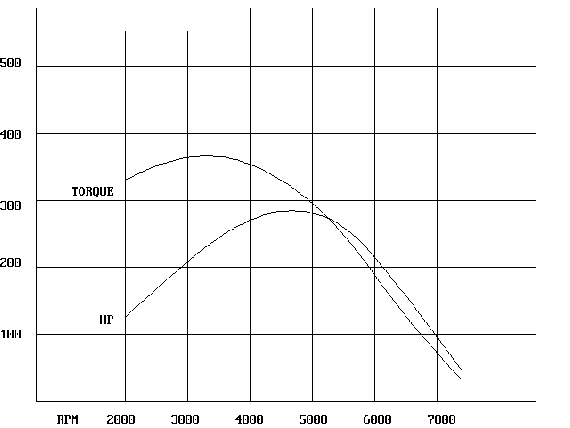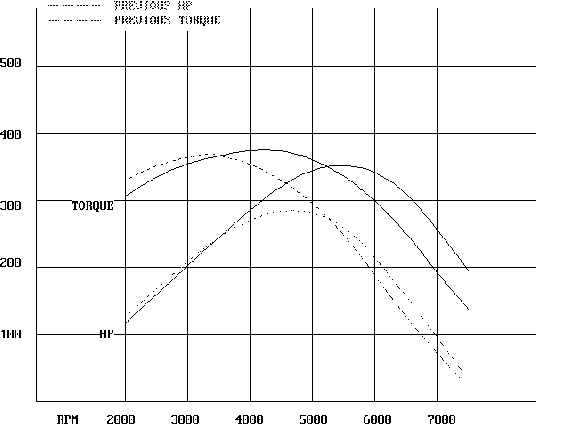
Is an engine built by the local hero or big name engine builder better than one you build with the same performance engine parts? Maybe and maybe not! You might feel that you can bolt an engine together with those same performance engine parts, but you just don't know the secrets to make big name power. Well, now you can forget that excuse! Software allows you to play "What if" games on the computer. In minutes you can learn what took years for those guys to learn with these car racing tips.
On the computer you can see the performance relationships of different engine parts. After that, all you need are some power goals and you can build a strong engine, too.
Many people mistakenly think peak horsepower or peak torque is the primary objective of performance engine parts. However, a single number means very little. Your goals should be the shape and location of the power curve. Basically, these goals have to do with the working RPM range of the engine and how the torque curve fits within that range.
The torque curve goals are really a very logical method to identify the performance objectives for the engine. Follow this logic and see if you don't agree:
At the Flywheel
The engine produces a torque at the flywheel. That torque is mechanically increased by the gears in the transmission and/or differential, resulting in a larger torque on the axle. That axle torque divided by the radius of the tire equals the force that pushes the car forward. The end, almost!
At the Low End!
Take two cars that weigh the same and have the same gears. As you come out of a turn or leave the lights, the car with the higher torque at this lower RPM will be the one to pull ahead.
However, too much torque will make a circle track or road race car loose (oversteer) exiting a corner. Drag cars that have too much torque will tend to "go up in smoke." This is why a light car with lots of peak torque may need to have the torque peak occur a little higher in the RPM range than at the lowest working RPM.
At the Top End!
Back to our comparison, as our two cars rev to the upper RPM, the one with the highest torque at this RPM will have the advantage. Beware though, if the torque comes in too late, you'll be too far behind to catch up!
Ideally you want a higher peak torque to pull away at lower RPMs and higher torque than the competition at the top RPM to keep pulling away. All you have to do is identify the RPM range, get some software, and before you know it you are building killer motors just like the pros.
For example, imagine you pick a combination of engine parts and the computer calculates the torque and HP as shown below. On this graph you can see that the torque peaks at approximately 3200 RPM. If you plan on working this engine between 4000 and 6500 RPM, then the peak is in the wrong place.

Now, try different engine parts in your engine software to see the resulting changes to the torque curve. The computer screen below shows the results after trying a different cam. Now, the torque curve has shifted to the right and into the appropriate RPM range.

Notice that the peak torque stayed roughly the same. However, for you die hard HP folks, look at what happened to the peak horsepower. So, if you take care of the torque curve, the horsepower will take care of itself.
Meanwhile back at the torque curve, your next objective is to keep the torque curve from falling off steeply after the peak. After that goal you will now want to simulate changes to the engine with your software so the whole curve moves vertically on the graph.
How to accomplish Torque Goals in the Engine
The physics behind engine power can genreally be lumped into three areas,
mechanical efficiency, volumetric efficiency and thermal efficiency.
Shaping the torque curve to fit your needs is quite simple with a computer program and the following logic: Mechanical efficiency mainly has to do with friction or parts of the engine that rob power. Volumetric efficiency can be thought of as how well the engine breathes. Thermal efficiency is the concept of heat and what happens to the heat.
Generally this is what you can expect: Improving the mechanical efficiency will increase the torque a little at the upper end RPM range. The peak of the torque curve tends to follows the peak volumetric efficiency. In other words, if the peak volumetric efficiency is at a lower or higher RPM then so is the torque peak. An increase in thermal efficiency tends to take the whole torque curve and move it higher on the torque scale.
For more illustrations on these changes see the Tips To Change Power page.